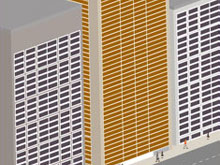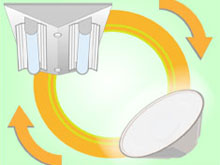Global warming mitigation technology field (lighting energy reduction technologies)
Outline of Technologies
Examples of Target Technologies
Reference Materials
- Protocol (Version 4: revised on September 4, 2014) [PDF/705KB]
A protocol defines the basic approach for the implementation of verification tests, test conditions, test methods and other relevant matters in the relevant technology field.
Particularly important are measures to reduce the energy used for lighting in buildings and homes as the energy consumption of lighting accounts for a large proportion of the total energy consumption of a building or house. Reduction of the power consumption for lighting almost means less generation of heat, reducing the power requirement for air-conditioning. What is required to further boost the significant effects of a reduced power consumption for lighting is an integrated approach incorporating appropriate auxiliary devices and novel lighting methods.
The use of reflectors and diffusers is a low cost and easy to implement measure to improve the lighting efficiency and can be widely introduced to buildings and houses.
The ETV Program assists the selection of technologies suitable for the needs of users by means of disclosing the results of technology verification tests conducted by third party organizations and providing various types of information required to judge the effectiveness of individual technologies.
A questionnaire survey with verification applicants in the past received such replies as “The number of enquiries about the technology has increased since verification” and “There have been certain positive effects on sales promotion and technological development activities”. Another reply concerning the issued logo was that “The logo has been attached to the product pamphlet, technical reports, company brochure, and company website”.


















 Lighting for building and houses
Lighting for building and houses reduction
of lighting energy using reflectors, etc.
reduction
of lighting energy using reflectors, etc.
